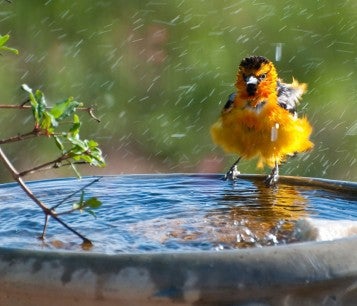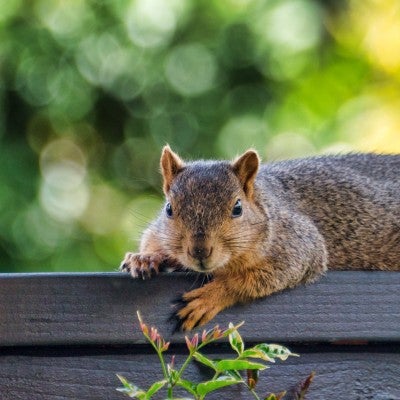Perhaps more than any other wild animal, rats have adapted to living among humans. Rats are adaptable survivors, consistently resisting increasingly dangerous and cruel attempts to exterminate them, from progressively stronger poisons (which can cause collateral damage to other wildlife) to a wide range of traps, including glue traps (which cause a prolonged, agonizing death). The only real way to resist rats long-term is to remove food, water and habitat from where you don’t want them.
Contents
No matter how big or small your outdoor space, you can create a haven for local wildlife. By providing basic needs like water, food and shelter, you can make a difference in your own backyard.

What are the signs I have rats? How do I know if I have rats or mice?
Never attempt to control a wildlife problem without first being sure of the species of wildlife. Some signs you have rats include:
- Shiny black droppings about half an inch long.
- Gnawed holes up to two inches wide in baseboards or at doorframes.
- Smudge marks (body oils) on walls.
- Scratching noises in walls, attics and vents.
- Pets staring intently at blank walls.
- Burrows and tunnels about as wide as a baseball outdoors, especially near foundations and walls. Cover openings with soil and check the next day to see if they have been reopened.
- Unpleasant ammonia smell (urine).
- Cereal bowl-sized nests made of cardboard, paper, insulation, dryer lint or fabric in attics and walls and under eaves.
How can I get rid of rats? How can I kill rats without hurting other animals?
Remove food, water and habitat
- Remove trash, wood piles and brush close to buildings.
- Remove English ivy from garden beds. (The vine serves as a perfect shelter for rats.)
- Store bird seed, grass seed and pet food in galvanized metal cans with tight-fitting lids.
- Use galvanized metal composters with tight-fitting lids.
- Use wildlife-proof trash cans or secure trash cans with bungee cords.
- Clean up dropped fruit from around fruit trees.
- Remove outdoor pet food bowls each night and use rat-proof treadle feeders for farm animals.
- Use no spill bird feeders filled with spicy bird seed or, if possible, remove bird feeders each night.
- Empty outdoor water bowls and bird baths each night and put away or cover farm animal waterers. (Rats like to live close to a water source. Regularly dumping out water also prevents mosquitoes.)
- Clean up pet droppings from the yard every day. (Rats will eat feces.)
Seal entry points
Rats can enter buildings through holes as small as 1 inch wide (about the size of a quarter), such as heating vents and gaps around utility lines and water pipes.
- Seal holes and other openings with 1/4-inch hardware cloth.
- Plug gaps in walls and floors with steel wool or copper mesh.
- Finish sealing openings with caulking or foam insulation.
- Use an L-shaped barrier of hardware cloth or concrete to prevent burrowing along foundations or under animal enclosures (like chicken coops) long-term. Rats are excellent diggers: Bury the footer at least 12 inches deep and extend it out from the foundation about 12 inches.
Repel with smells
Repellants will not work if you already have a rat population, but you can use them as a part of your long-term prevention methods.
- Consider Varpel Rope®, a registered repellent for mice and rats. The active ingredient is used in making mothballs.
- Plant mint, lavender and citronella in full sun next to your foundations. (Mint can easily grow out of control, so keep it in pots.)
- Regularly scatter dried mint leaves around your home and/or spray peppermint oil around your foundations.
- Sprinkle cinnamon around your foundations.
- Soak cotton balls in vinegar and leave them where rats like to burrow.

What is the “most humane” way to kill rats? What is the best rat trap or rat poison?
Typically, conditions that support high rat populations are left until there’s a crisis. Traps and poison are a temporary “fix” that do not control rats long-term. To remove rats from your environment, you must remove the food, water and habitat that are supporting rat populations in the first place. If you continue to provide food, water and habitat while trapping and poisoning rats, you are creating a never ending cycle of attracting and killing rats.
There are no truly humane ways to kill rodents, only methods that are less inhumane. Never use glue traps, which have been banned in several countries for their extreme cruelty, and bear in mind that rat poison can kill other wild animals, such as foxes, owls and hawks. Based on what we know about lethal control methods, strong snap traps (the traditional wood and metal kind, not the plastic kind) and traps that use an electrical charge to stun and kill seem to be the least inhumane.
Do rats carry disease?
Rats are considered carriers or transmitters of more human diseases than any other life form, except maybe the mosquito. More than 15,000 rat bites are reported each year in the United States. All rat bites should be treated by a doctor. Some of the diseases that can be spread from rats to people are bubonic and pneumonic plague, murine typhus, salmonella, leptospirosis, Hantavirus and tularemia.

